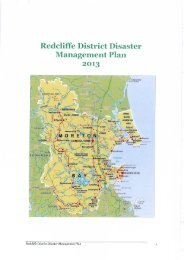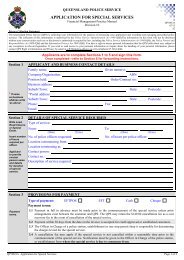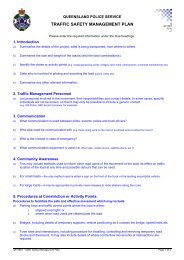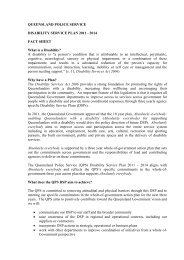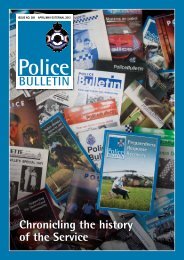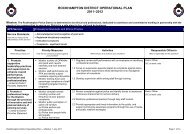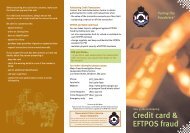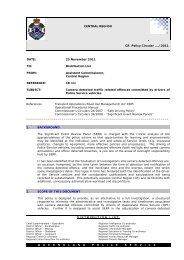FRoM CoMMissioneR ATKinson - Queensland Police Service ...
FRoM CoMMissioneR ATKinson - Queensland Police Service ...
FRoM CoMMissioneR ATKinson - Queensland Police Service ...
You also want an ePaper? Increase the reach of your titles
YUMPU automatically turns print PDFs into web optimized ePapers that Google loves.
colleagues, can be invaluable<br />
to investigators.<br />
In a recent case, Sergeant<br />
North applied the technique<br />
when investigating a skull<br />
found at a waste facility at<br />
Willawong, in Brisbane’s<br />
south. An external assessment<br />
revealed what looked like a<br />
piece of metal embedded<br />
in the bone. An x-ray<br />
examination in the field<br />
showed that the object was<br />
a screw. Models made for<br />
medical students use real<br />
bones and investigators were<br />
able to conclude the skull was<br />
part of a discarded medical<br />
model and not a victim of a<br />
crime.<br />
Sergeant North is one of<br />
only four scientific officers<br />
licensed and retrained<br />
annually to adhere to the<br />
strict safety guidelines that<br />
apply to operating radiation<br />
equipment.<br />
The State Coroner has<br />
authorised these officers to<br />
conduct x-ray examinations<br />
on bodies related to crime<br />
scenes.<br />
Sergeant North said one of<br />
the greatest benefits of the<br />
technology was the speed<br />
and convenience in which<br />
An external assessment reveals what looked like a piece of<br />
metal embedded in a skull discovered at a waste facility. An x-ray<br />
examination in the field reveals that the object is a screw, and<br />
investigators are able to conclude the skull is part of discarded<br />
medical model and not a victim of a crime.<br />
suspicious deaths could be<br />
ruled out.<br />
“I was recently on a course in<br />
Hobart when I was asked to<br />
look at some bones that were<br />
photographed by a Scenes<br />
of Crime officer in Emerald,<br />
<strong>Queensland</strong>.<br />
“Using the Toughbook laptop<br />
computer, I was able to<br />
view the images and make<br />
a determination. I could see<br />
immediately they were only<br />
animal bones. It was great to<br />
have the opportunity to do<br />
this visual examination from<br />
another state. The wireless<br />
digital system is great. In the<br />
old days it would have taken<br />
days. Now it takes seconds.”<br />
<strong>Queensland</strong> <strong>Police</strong> forensic<br />
officers are recognised as<br />
experts in their field and<br />
their services are often<br />
requested to assist in<br />
overseas operations. Last<br />
August, the Australian Army<br />
invited Sergeant Donna<br />
MacGregor to be the forensic<br />
anthropologist on a specialist<br />
team to examine fragmentary<br />
human remains located at<br />
Rabaul, Papua New Guinea.<br />
The remains were located<br />
during local excavation work<br />
near Rabaul, along with<br />
various artefacts believed to<br />
belong to Australian soldiers.<br />
The identification process<br />
proved to be a daunting<br />
task, as the fragments had<br />
been mixed together and<br />
packaged into three boxes.<br />
The forensic team succeeded<br />
in identifying the remains of<br />
five young men of Caucasian<br />
ancestry, however they were<br />
not Australian, but rather from<br />
the subcontinent of India.<br />
Fingerprint Bureau<br />
While the science of using a<br />
person’s unique fingerprints<br />
to prove identification and<br />
solve crime has been in<br />
use since 1904, the QPS<br />
Fingerprint Bureau has greatly<br />
improved the technology over<br />
the past five years.<br />
Livescan was introduced in<br />
2006 and scanning equipment<br />
is now installed at 25 locations<br />
throughout <strong>Queensland</strong>, as<br />
Technicians in the Electronic Recording Section enhance poor quality video and<br />
audio recordings for investigative purposes and for presentation in court. This work<br />
can include preparing CCTV footage for media release (left), and improving vocal<br />
intelligibility of an audio recording by removing background noise (right).<br />
<strong>Police</strong>Bulletin347 13




